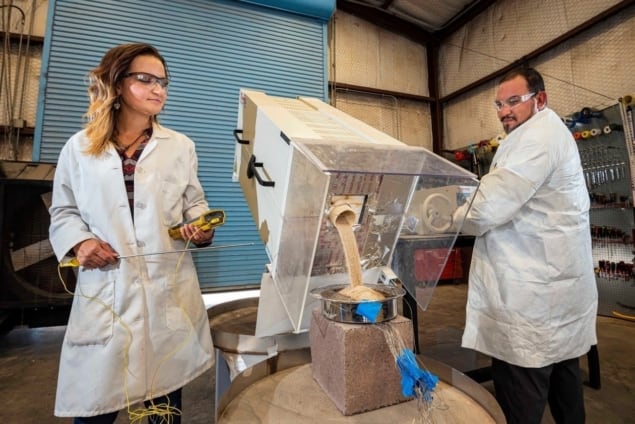
A new way of cooling and containing the radioactive, lava-like mass that forms in the core of a nuclear reactor during a catastrophic meltdown has been developed by researchers in the US. The technique involves using granular carbonate materials rather than water and has been demonstrated in both small and large-scale testbeds using molten lead oxide. The developers are now working toward a commercial application of the system.
When a nuclear plant undergoes a catastrophic meltdown, a radioactive lava-like mixture of nuclear fuel, control rods, fission products and the reactor’s structural components can form. Dubbed “corium”, this molten mass is both extremely dangerous and has the potential to move.
“During a severe reactor accident, the vessel that contained the fuel melts and ruptures,” explains Sandia National Laboratories engineer David Louie. “Then all that stuff falls out on the containment floor and starts spreading.”
Exploding hydrogen
Meltdown can escalate the release of radioactive material into the surrounding environment in two ways, the first of which is corium’s potential to melt through the floor of the reactor building and seep into the underlying soil. The molten mass could also react chemically with surrounding materials such as concrete to create hydrogen gas that can build up and cause an explosion.
The standard technique for dealing with corium is to try and cool it with water. However, this approach typically works too slowly, allowing the disaster to continue evolving and letting radioactive contaminants escape into the surrounding area.
“Eventually corium stops spreading because water will cool it down,” Louie said. “But you don’t want the accident to get worse and worse while you’re working to bring water in. The water also provides a source of explosive hydrogen.”
Looking for a better method to cool and contain corium, Louie and colleagues turned to granular carbonate minerals like calcite and dolomite, which they say could be injected into the heart of reactors in the event of a meltdown.
Small-scale test
Beginning with a small-scale test, the team heated a few grams of lead oxide powder to 1000 °C to create a molten material similar to corium. They then combined this with both a sample of granular calcite and, for comparison, grains of silicon dioxide (sand).
“We saw that the injectable carbonate minerals work,” Louie said. “It reacted chemically to produce a lot of carbon dioxide, which ‘leavened’ the lead oxide into a nice cake-like structure. The reaction itself had a cooling effect, and all the pores in the ‘cake’ allow for further cooling.” In contrast, the sand used as the control sample had no effect on the simulated corium.
A follow-up experiment, run on a kilogram-scale, also showed that carbonate granules could be successfully applied to contain the molten material. The researchers have also incorporated their injectable safety materials into Sandia’s reactor meltdown modelling software to examine how granular carbonates might affect an unfolding real-world nuclear disaster – such as the one that occurred at Japan’s Fukushima Daiichi power plant in 2011.
“While there are many ways to make nuclear power safer, solutions such as travelling wave reactors and molten salt reactors often involve completely new infrastructure, which may take decades to develop,” says physicist Lawrie Skinner of Stanford University, who was not involved in the present study. He adds, “This carbonate injection method offers a simple way to make current reactor technology safer.”
Larger demonstrations needed
“Although it still needs to be experimentally demonstrated at larger scales and with materials that closely match nuclear melts, it will be exciting to see how these carbonate injection methods perform.”
Oliver Alderman of Materials Development Inc. has previously studied corium lava and calls the new research “a very nice concept”. “I do wonder about the effect of corium temperature — corium can be much hotter than the molten lead oxide used — and also about secondary exothermic reactions that may occur,” he cautions.
He adds, “Another interesting point to consider is that the thermal conductivity of the ‘cake’ material is likely to be very low, and this could be an advantage, or disadvantage, depending upon the reactor design”.
With their initial study complete, the researchers now have a non-provisional patent underway for the injectable safety materials and are also looking to perform even larger-scale tests, but with the incorporation of depleted uranium.
“After that, we’d be ready to commercialize the technology,” Louie said, adding that the carbonate containment materials “could be retrofitted into any existing nuclear reactor design”.
Sandia National Laboratories is calling for expressions of interest from other research groups and organizations interested in partnering on future work into this approach to corium containment.



